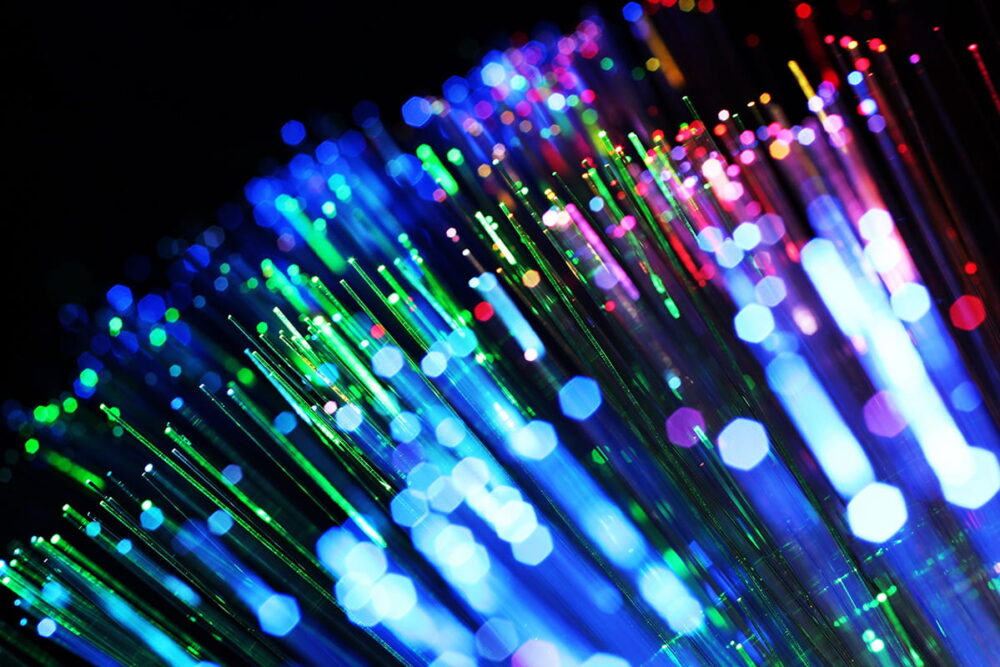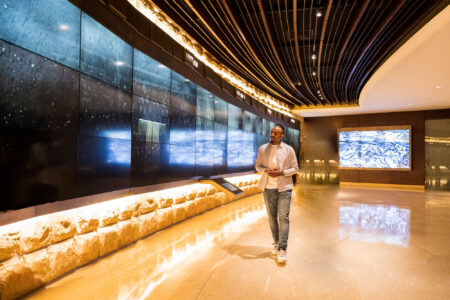April 29, 2020
Fiber: It’s Good for You!

When it comes to signal management and distribution, the AV industry primarily relies on HDMI cables, USB cables, category cables, and shielded/unshielded audio cables. In other words, a steady diet of copper gets us from Point A to Point B and beyond. If we’re able to keep the distances between Point A and Point B to a reasonable number, and our bandwidth requirements aren’t excessive, then all is well.
But what happens when our video and audio signals need to traverse a distance longer than a few hundred feet? After all, the copper wire does have some degree of resistance and, by extension, attenuation. What’s more, as the frequency of the transported signal (clock rate) increases, the electrons start moving from the center of the cable to the outer part, a phenomenon known as the “skin effect.”
Eventually, the frequency of the signals in use becomes so high that they leave the cable altogether and travel as photons through the air, which is why television stations broadcasting on UHF frequencies use tuned waveguides to couple energy from a transmitter to the antenna. The transmission resembles more of an elaborate plumbing job than anything else!
We could extend AV signals over long distances by converting electrons into photons, i.e. light energy. But we’ll need a suitable transmission medium to carry those pulses of light from Point A to Point B. And that’s where optical fiber cable comes in: It’s able to move those photons from a transmitter to a receiver over very long distances with minimal signal attenuation and degradation.
Let’s say you need to run a l-o-n-g HDMI extension to a remote display, mounted about one thousand feet from the source. HDMI, by itself, won’t get you much more than 25 – 50 feet. HDBaseT extensions are only good to about 300 feet. And a network interface isn’t available for this extension. What to do?
Simple. You’ll need an HDMI-to-optical fiber transmitter/receiver set. The transition-minimized differential signals (TMDS) from the HDMI source become pulses of light, ready to fly through space. If you connect a fiber optic cable using multimode transmission – meaning that the pulses of light reflect multiple times off the core of the fiber as they travel – then you can extend the original signal up to 1.8 miles.
If you elect to use single-mode optical fiber (the pulses of light travel in a relatively straight line through the core of the fiber), then you can extend your source signal all the way out to 20 miles for a reliable connection. The choice is up to you! Keep in mind that multimode optical fiber cable is cheaper than single-mode cable (not to mention Cat6 network cable) and is more than adequate for the above example.
There are a ton of advantages to using fiber optic cable. For one thing, it’s completely isolated from interference, both man-made and natural. It’s also unaffected by ground loops (differential voltages) and magnetic fields. Given its low attenuation per foot, you can just buy a pre-assembled cable with connectors, run the cable, and loop up the excess – no need to trim and re-attach connectors. Or, you can make up your own cables – crimp-on connectors for optical fiber are quite easy to use these days.

Some integrators have already jumped on the fiber wagon. 10-gigabit network switches support both copper wire or optical fiber through small form-factor pluggable (SFP) connections, and it’s likely that faster switches will rely mostly on fiber connections – the signal attenuation over the copper wire at higher frequencies is substantial, once the cable run exceeds ten feet.
Fiber optic cable doesn’t take up much room, either. Bundled cables with multiple fibers can be run and laid in overhead cable trays easily enough. (Just don’t put a tight bend in them!) By building out a facility with fiber interconnects to all rooms and spaces, you’ve ensured your facility is future-proofed. If another audio or video signaling format comes into vogue, or your bandwidth demands increase, you simply change out the optical interface – no need to pull new cables.
While the current version of HDMI our industry relies on (v2.0) uses the TMDS format, the next version (v2.1) and all versions of DisplayPort employ a packet-based digital transmission system. That’s an even better match for optical fiber transmission! What’s cool about fiber is that we can multiplex audio, video, control, and metadata all through the same cable, at the same time. We do this with a variety of tricks, including time division (spacing out different packets), code division (coding packets), and wave division multiplexing. With the later process, different wavelengths of light carry different signals.
It should come as no surprise that Kramer supports optical fiber signal distribution. The 676T 4K60 4:4:4 HDMI Transmitter over Ultra-Reach MM/SM Fiber Optic Transmitter and companion 676R Receiver are designed to extend HDMI v2.0 signals over very long cable runs. These useful gadgets couldn’t be easier to set up and operate – all you need to do is provide the fiber optic connection, using a type LC connector at both ends. For shorter runs, the multimode cable does the trick, while single-mode fiber will handle the long-haul stuff.
676T and 676R use near-zero latency video chroma sub-sampling conversion technology to auto−adapt HDMI signals with data rates above 10 Gb/s to a 10G optical link signal data rate. Both units are HDCP 2.2 compliant and support data rates up to 18G (6G per channel), along with LPCM 7.1, Dolby True HD, and DTS-HD audio formats, as specified in HDMI 2.0. Additionally, Kramer’s I-EDIDPro™ Intelligent EDID Processing™ ensures plug-and-play operation for HDMI source and display systems.
If you’re moving to or have already adopted SDVoE network-based AV signal distribution, there’s a Kramer optical interface product for that, too. KDS-8F is a high-performance, zero latency, 4K@60Hz (4:4:4) transceiver for streaming video and audio via Ethernet over single-mode and multimode optical fiber. And it is ambidextrous: KDS-8F can encode and stream its HDMI or DisplayPort input multiplexed with IR and RS-232 control signals, plus analog audio and USB; all over an IP network. Or, it can receive an SDVoE-encoded signal and decode it for HDMI output, along with control, audio, and USB.
For ruggedized operations, Kramer also offers the CRS-PlugNView-H cable. It’s a high-speed HDMI active, armored optical cable (AOC) designed for heavy-duty use and abuse expected from rental and road applications. These cables support resolutions up to 4K@60 (4:4:4) 18 Gbps over long distances without an external power supply or additional extenders. You can get ‘em in a variety of lengths from 33 to 328 feet.
Remember – fiber is good for you!
Would you like to consult with Kramer?








